Search Result
Results for "
oxalate
" in MedChemExpress (MCE) Product Catalog:
3
Biochemical Assay Reagents
11
Isotope-Labeled Compounds
| Cat. No. |
Product Name |
Target |
Research Areas |
Chemical Structure |
-
- HY-A0118A
-
|
NKTR-118 oxalate; AZ-13337019 oxalate
|
Opioid Receptor
|
Neurological Disease
|
|
Naloxegol oxalate (NKTR-118 oxalate; AZ-13337019 oxalate) is a μ-opioid-receptor antagonist. Naloxegol oxalate inhibits opioid binding in μ-opioid receptors in the gastrointestinal tract and effective for alleviating opioid-induced constipation .
|
-

-
- HY-135810A
-
|
Desethylhydroxychloroquine oxalate
|
Influenza Virus
Parasite
|
Infection
Inflammation/Immunology
|
|
Cletoquine oxalate (Desethylhydroxychloroquine oxalate) is a major active metabolite of Hydroxychloroquine. Cletoquine oxalate is produced in the liver by CYP2D6, CYP3A4, CYP3A5, and CYP2C8 isoenzymes. Cletoquine oxalate is also a Chloroquine derivative and has the ability to against the chikungunya virus (CHIKV). Cletoquine oxalate has antimalarial effects and has the potential for autoimmune diseases treatment .
|
-

-
- HY-13410
-
|
LY246708 oxalate
|
mAChR
|
Neurological Disease
|
|
Xanomeline oxalate (LY246708 oxalate) is a potent and selective muscarinic receptor agonist (SMRA) and stimulates phosphoinositide hydrolysis in vivo. Xanomeline oxalate can be used for the research of Alzheimer’s disease .
|
-
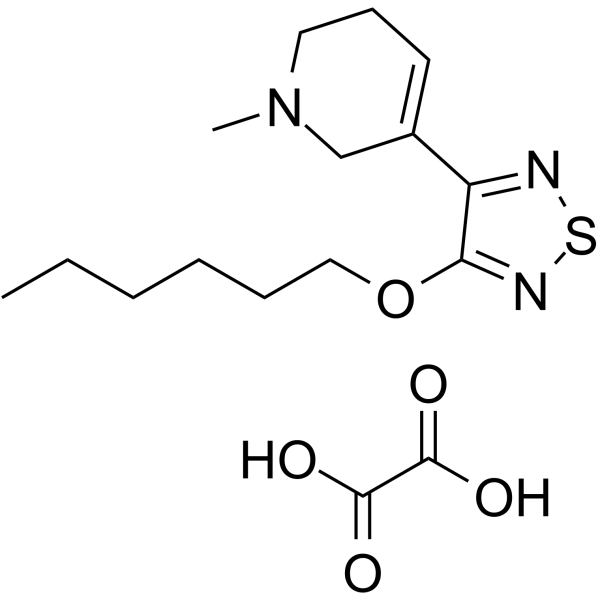
-
- HY-152849A
-
|
HL5101 oxalate
|
c-Met/HGFR
|
Cancer
|
|
Boditrectinib oxalate is a potent tyrosine kinase inhibitor. Boditrectinib oxalate serves as an antineoplastic agent. Boditrectinib oxalate is useful in the research of cancer, inflammation, neurodegenerative diseases and certain infectious diseases .
|
-
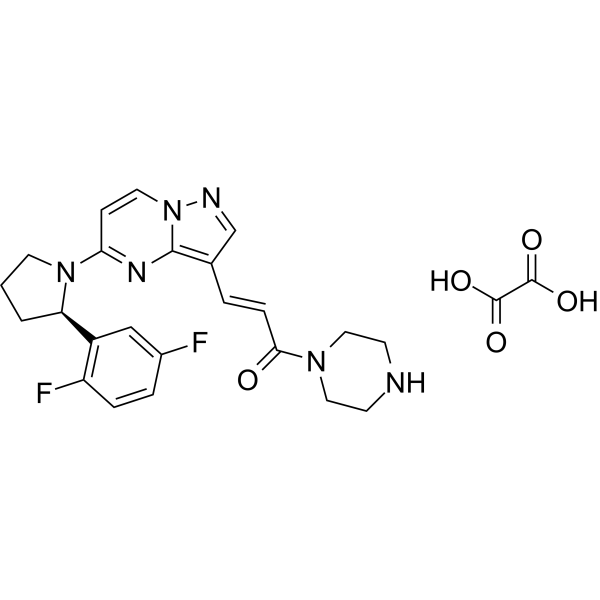
-
- HY-13225
-
|
RJR-2403 oxalate; (E)-Metanicotine oxalate
|
nAChR
|
Neurological Disease
|
|
Rivanicline oxalate (RJR-2403 oxalate; (E)-Metanicotine oxalate) is a neuronal nicotinic receptor agonist, showing high selectivity for the α4β2 subtype (Ki=26 nM); > 1,000 fold selectivity than α7 receptors(Ki= 3.6 μM).
|
-
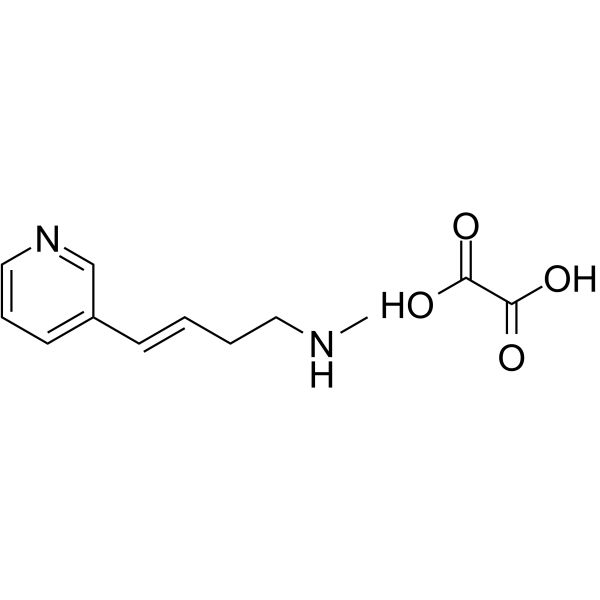
-
- HY-14258AR
-
|
(S)-Citalopram oxalate (Standard); (S)-(+)-Citalopram oxalate (Standard)
|
Serotonin Transporter
|
Neurological Disease
Cancer
|
|
Escitalopram (oxalate) (Standard) is the analytical standard of Escitalopram (oxalate). This product is intended for research and analytical applications. Escitalopram ((S)-Citalopram) oxalate, the S-enantiomer of racemic Citalopram, is a selective serotonin reuptake inhibitor (SSRI) with a Ki of 0.89 nM. Escitalopram oxalate has ∼30 fold higher binding affinity than its R(-)-enantiomer and shows selectivity over both dopamine transporter (DAT) and norepinephrine transporter (NET). Escitalopram oxalate is an antidepressant for the research of major depression .
|
-
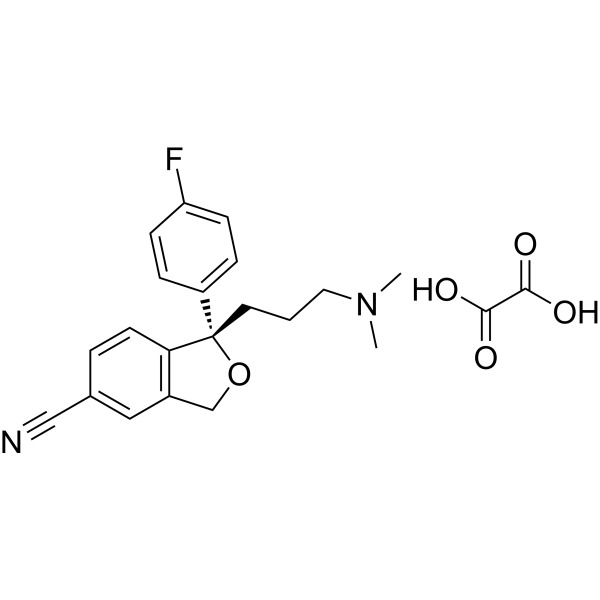
-
- HY-14258A
-
|
(S)-Citalopram oxalate; (S)-(+)-Citalopram oxalate
|
Serotonin Transporter
|
Neurological Disease
|
|
Escitalopram ((S)-Citalopram) oxalate, the S-enantiomer of racemic Citalopram, is a selective serotonin reuptake inhibitor (SSRI) with a Ki of 0.89 nM. Escitalopram oxalate has ∼30 fold higher binding affinity than its R(-)-enantiomer and shows selectivity over both dopamine transporter (DAT) and norepinephrine transporter (NET). Escitalopram oxalate is an antidepressant for the research of major depression .
|
-
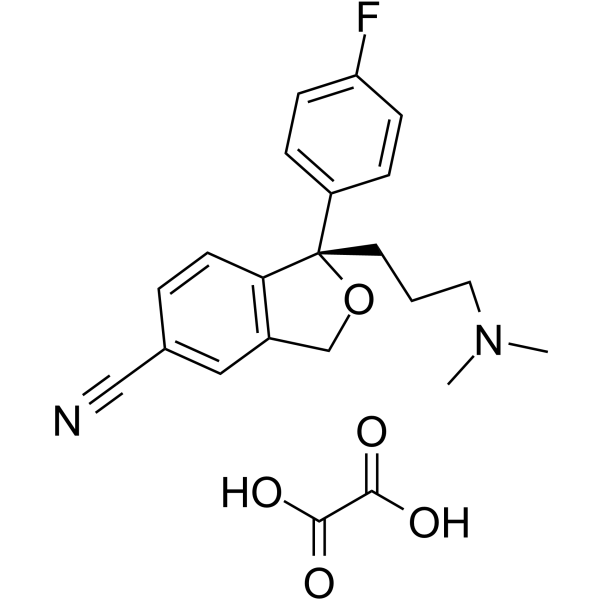
-
- HY-B1107
-
|
Nafronyl oxalate salt
|
5-HT Receptor
|
Cardiovascular Disease
|
|
Naftidrofuryl oxalate (Nafronyl oxalate salt) is a drug used in the management of peripheral and cerebral vascular disorders as a vasodilator, enhance cellular oxidative capacity, and may also be a 5-HT2 receptor antagonist.
|
-
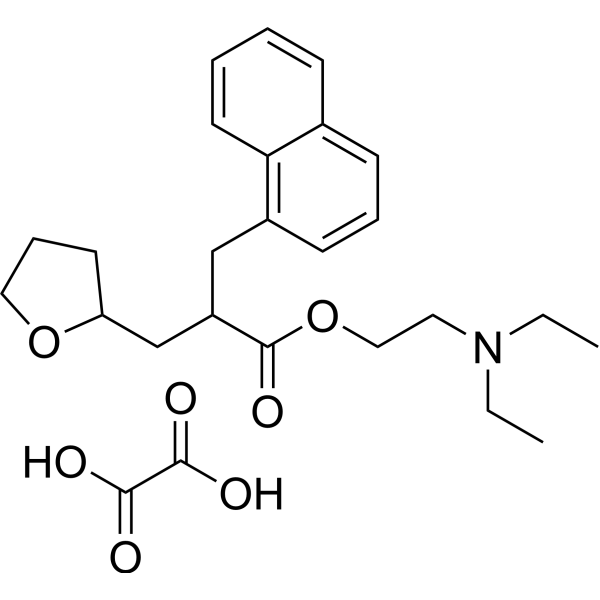
-
- HY-A0118AS
-
|
|
Isotope-Labeled Compounds
Opioid Receptor
|
Neurological Disease
|
|
Naloxegol-d5 (oxalate) is deuterium labeled Naloxegol (oxalate). Naloxegol oxalate (NKTR-118 oxalate; AZ-13337019 oxalate) is a μ-opioid-receptor antagonist. Naloxegol oxalate inhibits opioid binding in μ-opioid receptors in the gastrointestinal tract and effective for alleviating opioid-induced constipation[1][2].
|
-
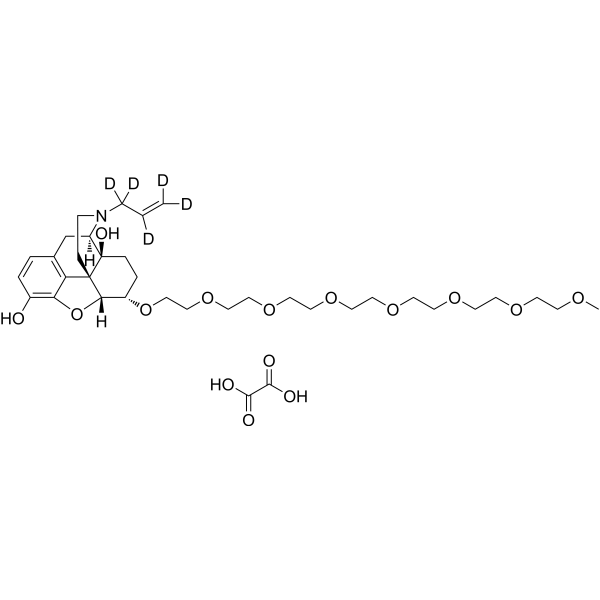
-
- HY-14258AS1
-
|
(S)-Citalopram-d4 oxalate; (S)-(+)-Citalopram-d4 oxalate
|
Isotope-Labeled Compounds
Serotonin Transporter
|
Neurological Disease
|
|
Escitalopram-d4 (oxalate) is deuterium labeled Escitalopram (oxalate). Escitalopram ((S)-Citalopram) oxalate, the S-enantiomer of racemic Citalopram, is a selective serotonin reuptake inhibitor (SSRI) with a Ki of 0.89 nM. Escitalopram oxalate has ∼30 fold higher binding affinity than its R(-)-enantiomer and shows selectivity over both dopamine transporter (DAT) and norepinephrine transporter (NET). Escitalopram oxalate is an antidepressant for the research of major depression[1][2].
|
-

-
- HY-121203S1
-
-

-
- HY-19695
-
|
L-p-Bromotetramisole oxalate; 6-Bromolevamisole oxalate
|
Phosphatase
|
Cancer
|
|
(-)-p-Bromotetramisole Oxalate is a potent and non-specific alkaline phosphatase inhibitor.
|
-
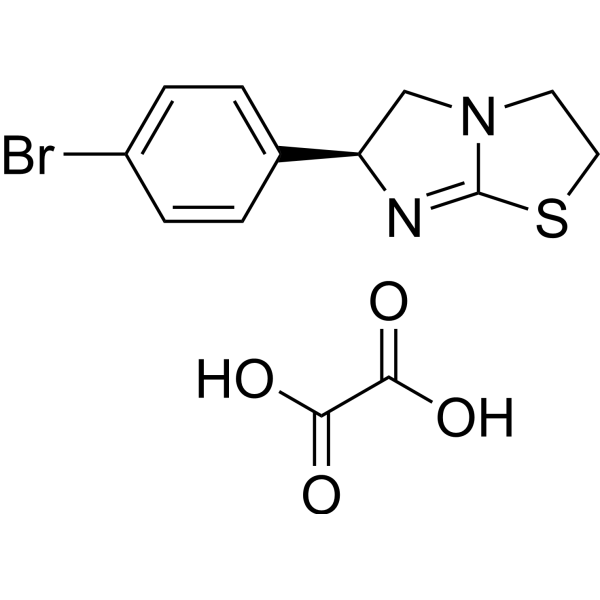
-
- HY-107759
-
|
UCL-1397 oxalate
|
Others
|
Neurological Disease
|
|
Butabindide (UCL-1397) oxalate is a potent, selective tripeptidvl peptidase II (TPP II) inhibitor with Ki values of 7 nM and 10 μM for TPP II and TPP I, respectively. Butabindide oxalate inhibits TPP II to protect CCK-8 against inactivation .
|
-
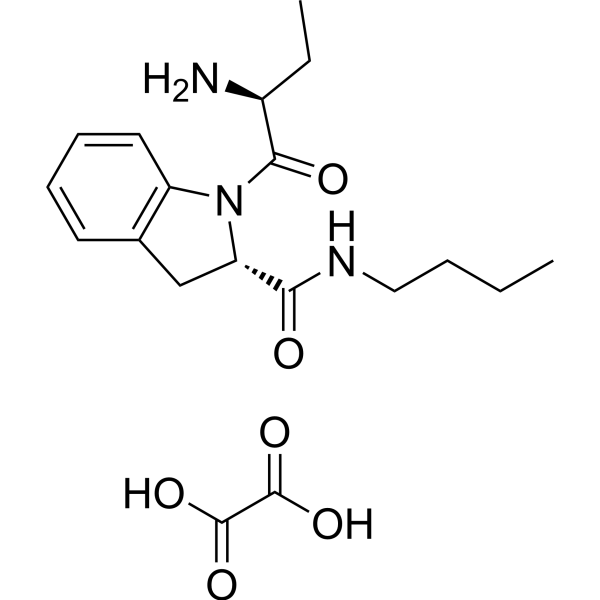
-
- HY-14258AS
-
|
|
Serotonin Transporter
|
Neurological Disease
|
|
Escitalopram-d6 (oxalate) is the deuterium labeled Escitalopram oxalate. Escitalopram ((S)-Citalopram) oxalate, the S-enantiomer of racemic Citalopram, is a selective serotonin reuptake inhibitor (SSRI) with a Ki of 0.89 nM. Escitalopram oxalate has ∼30 fold higher binding affinity than its R(-)-enantiomer and shows selectivity over both dopamine transporter (DAT) and norepinephrine transporter (NET). Escitalopram oxalate is an antidepressant for the research of major depression[1][2].
|
-
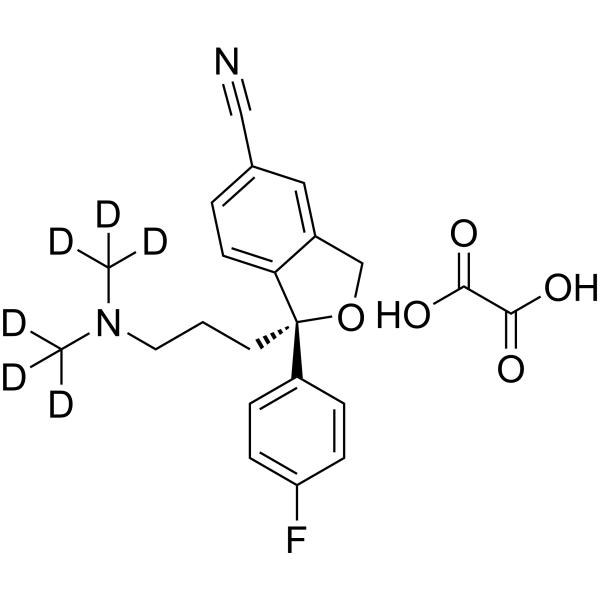
-
- HY-132373S
-
-

-
- HY-143931S
-
-
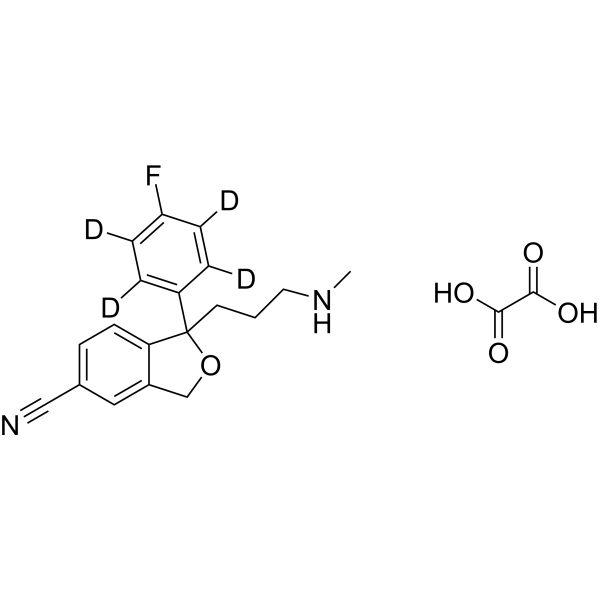
-
- HY-107656
-
|
|
mAChR
|
Neurological Disease
|
|
PTAC oxalate is a selective muscarinic receptor ligand. PTAC oxalate is an partial agonist of M2 and M4 but antagonist of M1, M3, and M5 (Ki values of 0.2-2.8 nM for hM1-5 in CHO cells). PTAC oxalate alleviates the mechanical allodynia on the neuropathic pain and has antidepression effects .
|
-
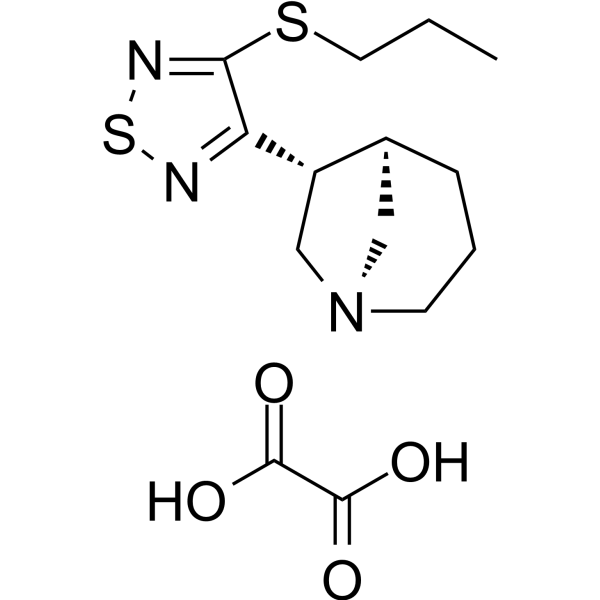
-
- HY-110289S1
-
-
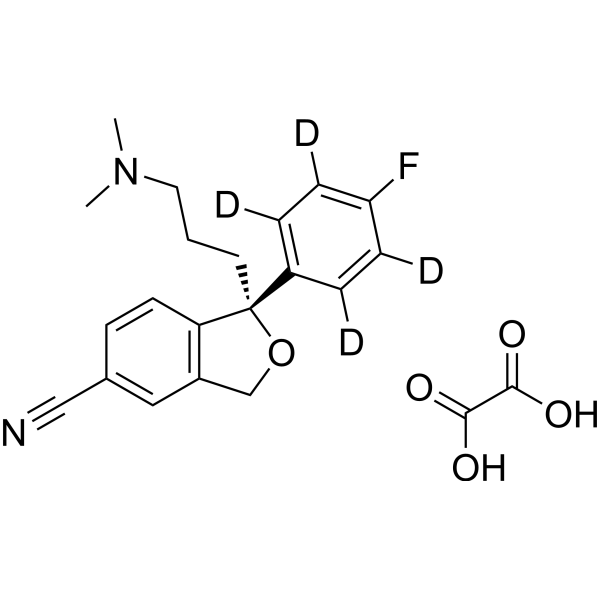
-
- HY-148669B
-
|
(S)-Menin-MLL inhibitor 24 oxalate
|
Epigenetic Reader Domain
|
Cancer
|
|
(S)-Bleximenib ((S)-Menin-MLL inhibitor 24) oxalate is a S-Enantiomer of (S)-Menin-MLL inhibitor 24 oxalate (HY-148669A). (S)-Bleximenib oxalate is a menin-mixed-lineage leukemia 1 (menin-MLL) inhibitor, and can be used for the research of cancer .
|
-

-
- HY-110289
-
|
|
Serotonin Transporter
5-HT Receptor
|
Neurological Disease
|
|
(R)-Citalopram oxalate is an anticonvulsant, antidepressant and muscle relaxant. (R)-Citalopram oxalate is at least 20-fold weaker than S-citalopram (Escitalopram; HY-14258) as inhibitor of the 5-HT transporter (SERT). (R)-Citalopram oxalate functionally antagonises S-citalopram in vivo and in vitro. (R)-Citalopram oxalate has an effect on the association of Escitalopram with the high affinity primary site, and on its dissociation from the 5-HT transporter, via an allosteric mechanism .
|
-
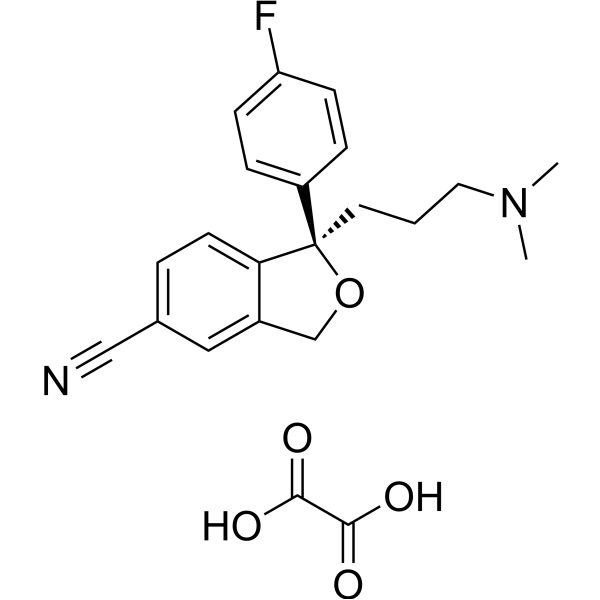
-
- HY-151910S1
-
-
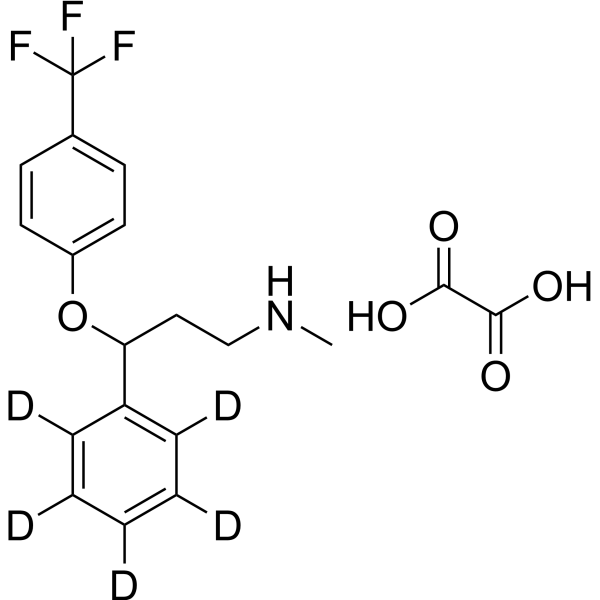
-
- HY-12199A
-
-
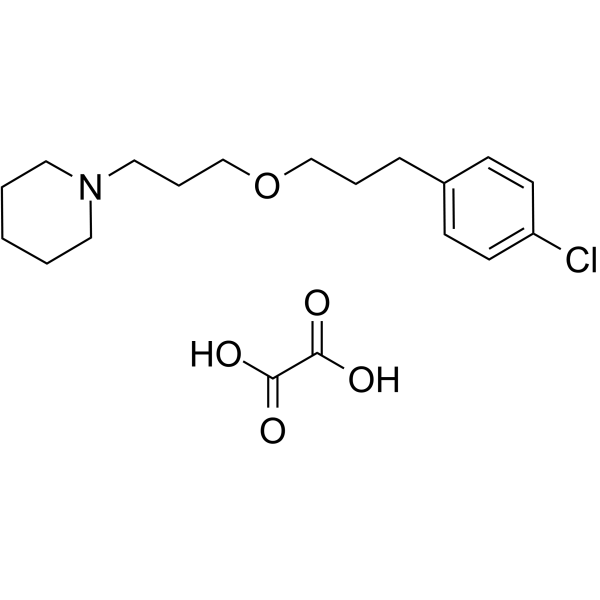
-
- HY-107460
-
|
|
Ephrin Receptor
|
Cancer
|
|
LDN-211904 oxalate (compound 32) is a potent and selective EphB3 inhibitor with an IC50 of 0.079 µM. LDN-211904 oxalate shows good metabolic stability in mouse liver microsomes. LDN-211904 oxalate with cetuximab could be effective in inhibiting STAT3-activated CSC stemness and cetuximab resistance in CRC .
|
-
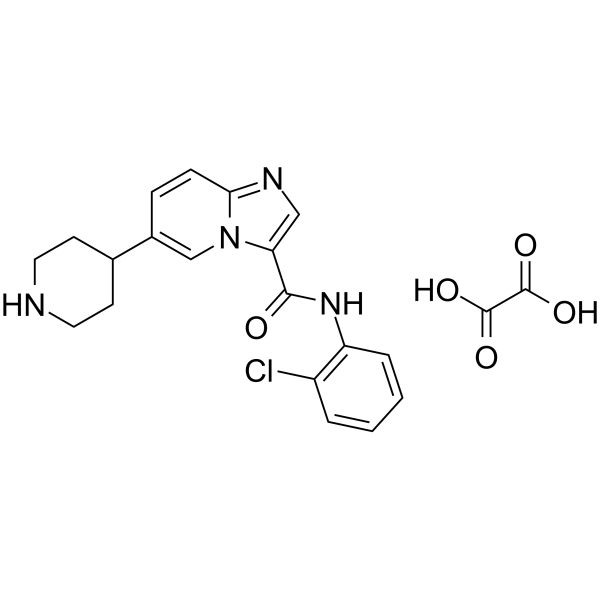
-
- HY-149854A
-
|
|
Sigma Receptor
|
Neurological Disease
|
|
AB21 oxalate is a potent and selective S1R antagonist with Kis of 13, 102 nM for S1R and S2R. AB21 oxalate has the effect of reducing mechanical hypersensitivity .
|
-
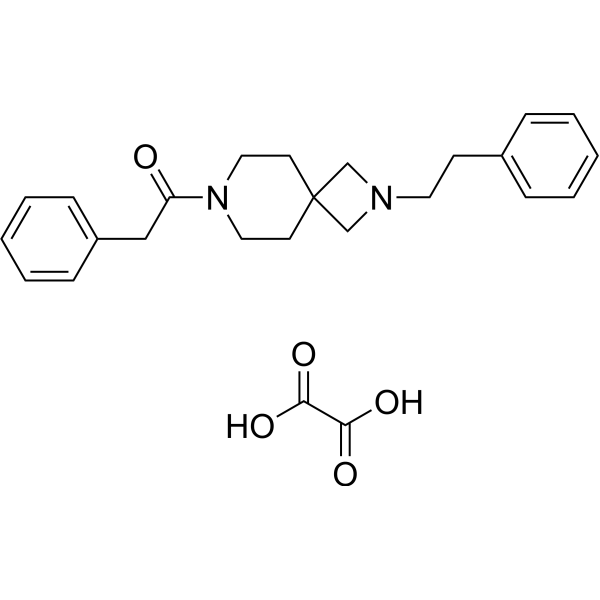
-
- HY-151910S
-
-
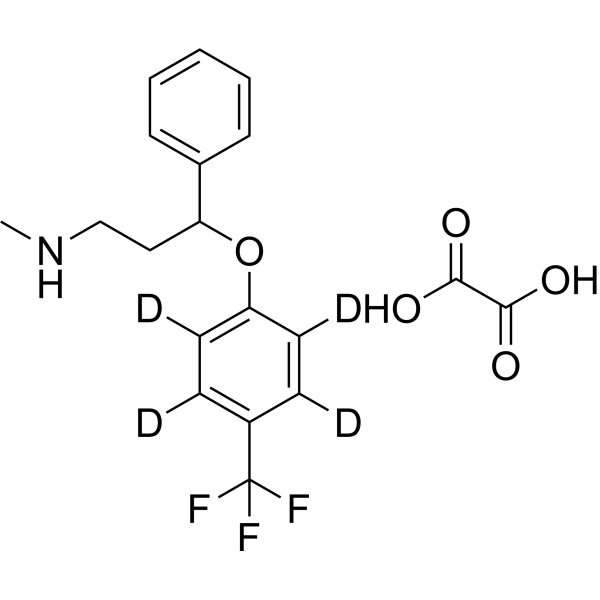
-
- HY-111081C
-
|
|
Sigma Receptor
|
Neurological Disease
|
|
(±)-PPCC oxalate is a sigma-1 agonist that mainly interacts with sigma-1 receptors with Ki of 1.5 nM. (±)-PPCC oxalate has effective anti-amnesia effects in rats with mild or severe cognitive impairment, and can improve the cognitive abilities of rats .
|
-
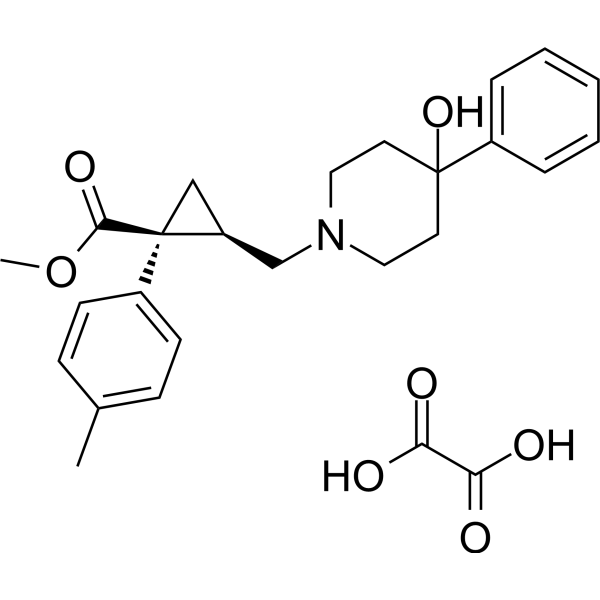
-
- HY-110366
-
|
SAX-187 oxalate
|
5-HT Receptor
|
Neurological Disease
|
|
WAY-181187 (SAX-187) oxalate is a potent and selective full 5-HT6 receptor agonist with a Ki of 2.2 nM and an EC50 of 6.6 nM. WAY-181187 oxalate mediates 5-HT6 receptor-dependent signal pathways, such as cAMP, Fyn and ERK1/2 kinase, as specific agonist .
|
-
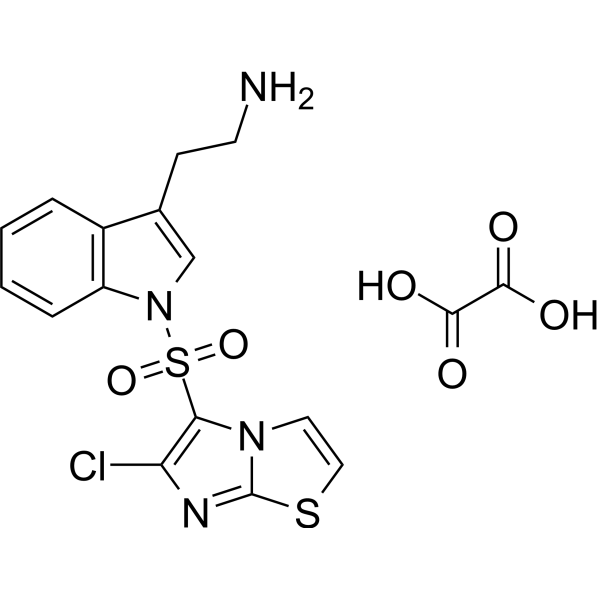
-
- HY-19668A
-
|
|
5-HT Receptor
|
Neurological Disease
|
|
SGS518 oxalate is a selective 5-HT6R antagonist. SGS518 oxalate can be used for the research of cognitive impairments such as amnesia, anxiety and depression, and it is effective in protecting mouse retina at high doses [1]
|
-

-
- HY-107758
-
|
|
Prolyl Endopeptidase (PREP)
|
Cancer
|
|
Y-29794 oxalate is a selective, orally active and blood-brain barrier permeable non-peptide prolyl endopeptidase inhibitor. Y-29794 oxalate blocks the IRS1-AKT-mTORC1 pathway and inhibits tumor growth. Y-29794 oxalate is also effective in inhibiting the progression of Aβ-like deposition in the hippocampus of aging-accelerated mice (SAM) .
|
-
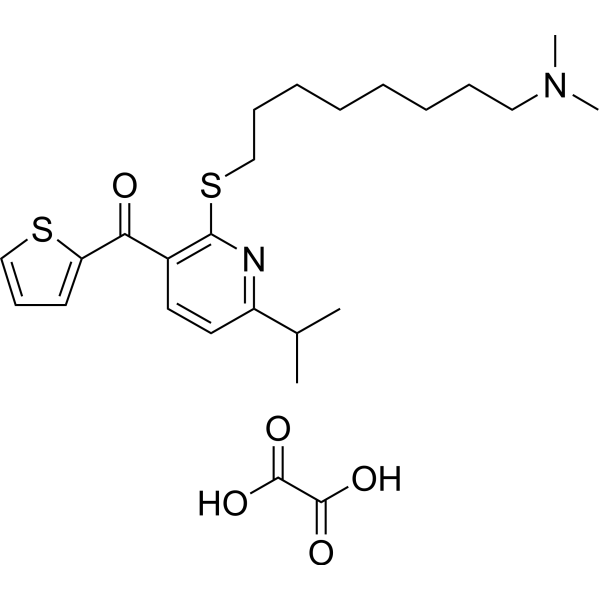
-
- HY-103098
-
-
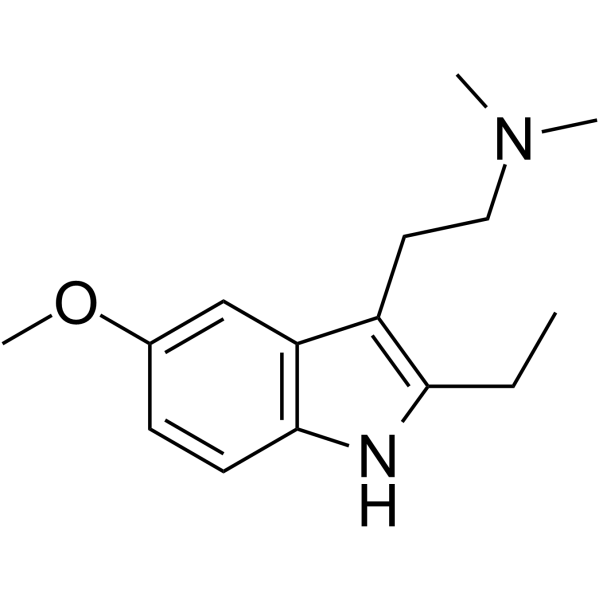
-
- HY-126568S1
-
-
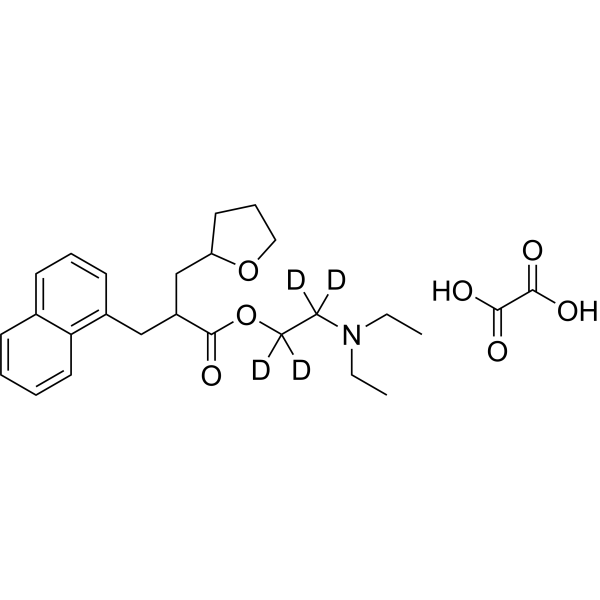
-
- HY-108512A
-
|
|
Sigma Receptor
|
Neurological Disease
|
|
PD 144418 oxalate is a highly affinity, potent and selective sigma 1 (σ1) receptor ligand (Ki values of 0.08 nM and 1377 nM for σ1 and σ2 respectively). PD 144418 oxalate devoids of any significant affinity for other receptors, ion channels and enzymes. PD 144418 oxalate shows potential antipsychotic activity .
|
-

-
- HY-137966A
-
|
AL-8520 oxalate
|
Carbonic Anhydrase
|
Cancer
|
|
N-Desethyl Brinzolamide oxalate is a dual inhibitor of Carbonic anhydrase II and Carbonic anhydrase IV with IC50s of 1.28 and 128 nM, respectively .
|
-

-
- HY-W127854
-
|
|
Biochemical Assay Reagents
|
Others
|
|
Bis(pentafluorophenyl) Oxalate is a biochemical reagent that can be used as a biological material or organic compound for life science related research.
|
-

-
- HY-148669A
-
|
Menin-MLL inhibitor 24 oxalate
|
Epigenetic Reader Domain
|
Cancer
|
|
Menin-MLL inhibitor 24 (compound A) oxalate is a menin-mixed-lineage leukemia 1 (menin-MLL) inhibitor, and can be used for the research of cancer .
|
-
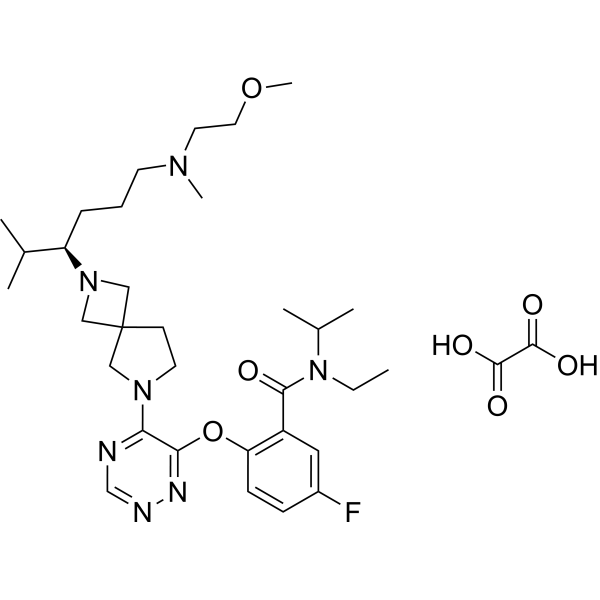
-
- HY-10261D
-
|
BIBW 2992 oxalate
|
EGFR
Autophagy
Apoptosis
c-Met/HGFR
Akt
|
Cancer
|
|
Afatinib (BIBW 2992) oxalate is an orally active, potent and irreversible dual specificity inhibitor of ErbB family (EGFR and HER2), with IC50 values of 0.5 nM, 0.4 nM, 10 nM and 14 nM for EGFR wt, EGFR L858R, EGFR L858R/T790M and HER2, respectively. Afatinib oxalate can be used for the research of esophageal squamous cell carcinoma (ESCC), non-small cell lung cancer (NSCLC) and gastric cancer .
|
-
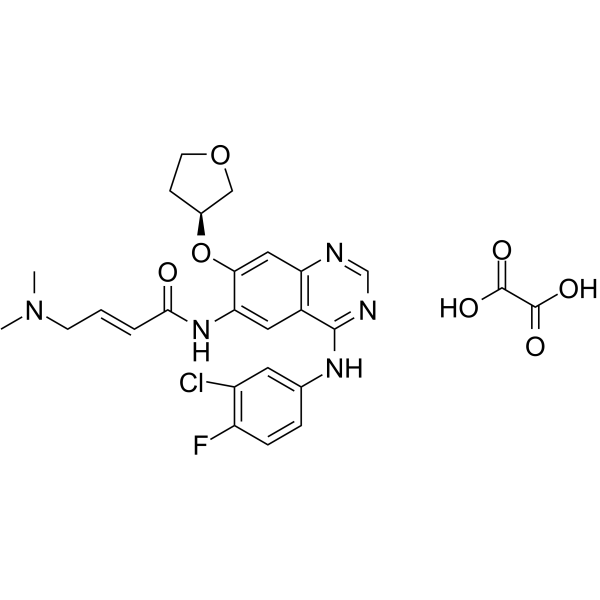
-
- HY-103110A
-
|
|
5-HT Receptor
Adrenergic Receptor
|
Neurological Disease
|
|
ST1936 oxalate is a selective, nanomolar affinity 5-HT6 receptor agonist with Ki values of 13 nM, 168 nM and 245 nM for human 5-HT6, 5-HT7 and 5-HT2B receptors, respectively. ST1936 oxalate also shows moderate affinity (Ki of 300 nM) for human and rat α2 adrenergic receptor .
|
-
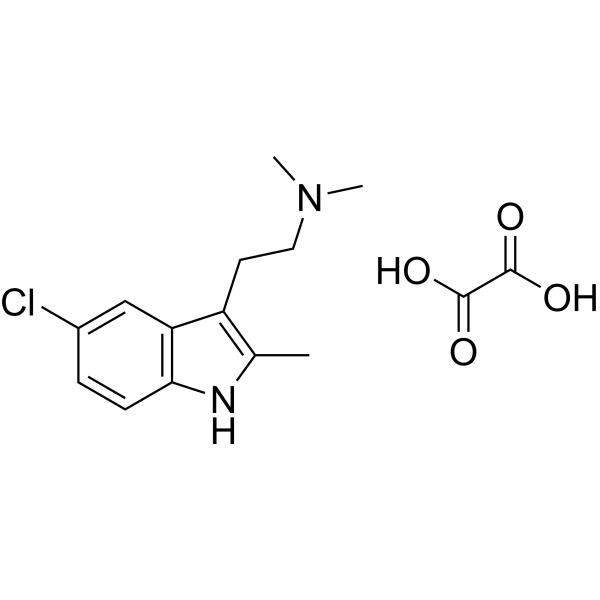
-
- HY-132475S
-
-
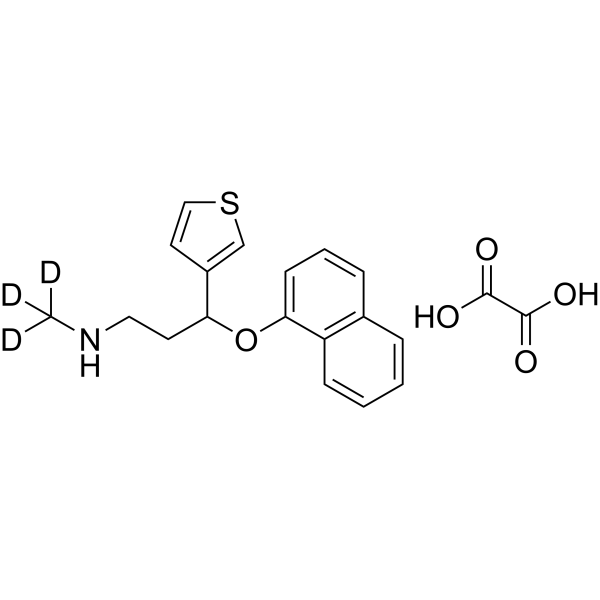
-
- HY-103113
-
-

-
- HY-W042438
-
|
|
Biochemical Assay Reagents
|
Others
|
|
Bis(2,4,6-trichlorophenyl) oxalate is a biochemical reagent that can be used as a biological material or organic compound for life science related research.
|
-

-
- HY-100970
-
|
|
|
|
|
4F 4PP (oxalate) is a selective 5-HT2A antagonist with almost as high affinity (Ki= 5.3 nM) as ketanserin but with a much lower affinity for 5-HT2C sites (Ki= 620 nM) .
|
-
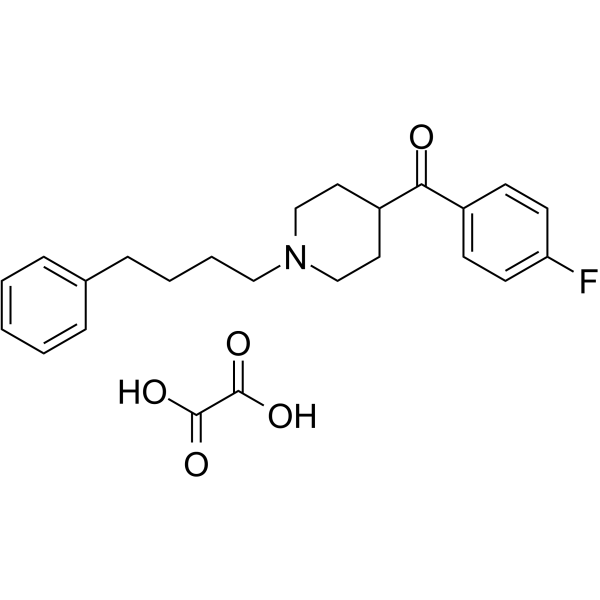
-
- HY-W099490
-
|
|
Fluorescent Dye
|
Others
|
|
Bis[3,4,6-trichloro-2-(pentyloxycarbonyl)phenyl] oxalate is a fluorescent dye that can be used for generation of chemiluminescence .
|
-
![Bis[3,4,6-trichloro-2-(pentyloxycarbonyl)phenyl] <em>oxalate</em>](//file.medchemexpress.com/product_pic/hy-w099490.gif)
-
- HY-132613
-
|
|
Small Interfering RNA (siRNA)
|
Metabolic Disease
|
|
Lumasiran sodium, an investigational RNA interference (RNAi) therapeutic agent, reduces hepatic oxalate production by targeting glycolate oxidase. Lumasiran sodium reduces urinary oxalate excretion, the cause of progressive kidney failure in primary hyperoxaluria type 1 (PH1) .
|
-
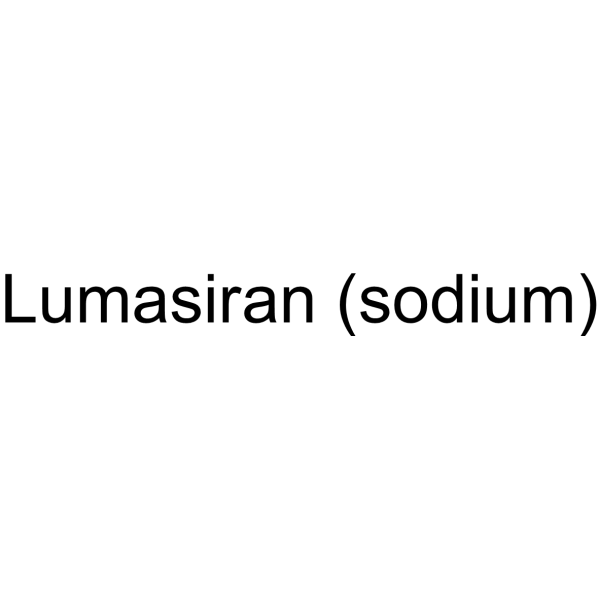
-
- HY-132588
-
|
ALN-G01
|
Small Interfering RNA (siRNA)
|
Metabolic Disease
|
|
Lumasiran (ALN-G01), a siRNA product, reduces hepatic oxalate production by targeting glycolate oxidase. By silencing the gene encoding glycolate oxidase, Lumasiran depletes glycolate oxidase and thereby inhibits the synthesis of oxalate, which is the toxic metabolite that is directly associated with the clinical manifestations of Primary hyperoxaluria type 1 (PH1) .
|
-

-
- HY-149276
-
|
|
GLUT
|
Metabolic Disease
|
|
SLC26A3-IN-2 is an orally active inhibitor of anion exchanger protein SLC26A3 (IC50=360 nM). SLC26A3 belongs to solute carrier (SLC) proteins, and the SLC26 family. SLC26 family has broad anion specificity for chloride, bicarbonate, sulfate and oxalate. SLC26A3 down-regulates in adenoma, DRA, involves in in intestinal absorption of chloride and oxalate. The loss of SLC26A3 function mutations is associated with chloride-losing diarrhea .
|
-

-
- HY-149802
-
|
|
GLUT
|
Metabolic Disease
|
|
SLC26A3-IN-1 is an inhibitor of anion exchanger protein SLC26A3 (IC50=340 nM). SLC26A3 belongs to solute carrier (SLC) proteins, and the SLC26 family. SLC26 family has broad anion specificity for chloride, bicarbonate, sulfate and oxalate. SLC26A3 down-regulates in adenoma, DRA, involves in in intestinal absorption of chloride and oxalate. The loss of SLC26A3 function mutations is associated with chloride-losing diarrhea .
|
-
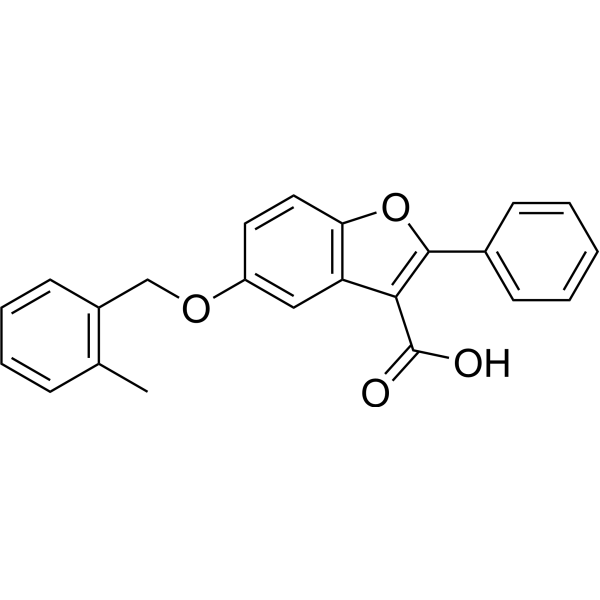
-
- HY-148610
-
|
|
Others
|
Metabolic Disease
|
|
LDH-IN-2, a salicylic acid derivative, is an inhibitor of glycolate oxidase (GO). LDH-IN-2 decreases oxalate output in hyperoxaluric hepatocytes. LDH-IN-2 can be used for research of primary hyperoxaluria type 1 (PH1) .
|
-
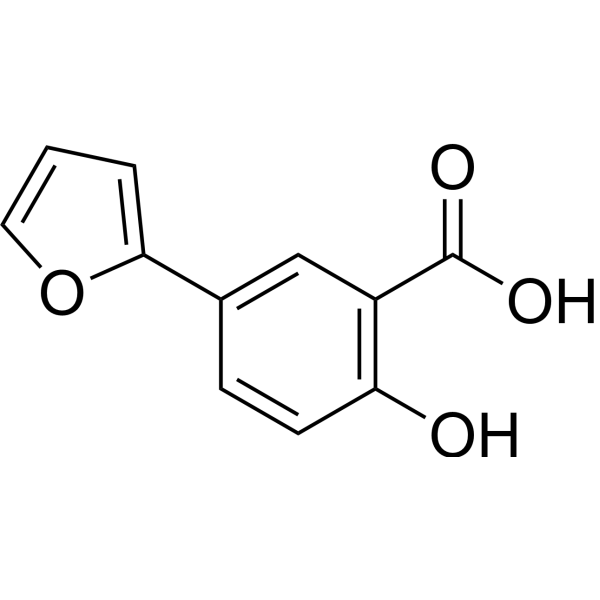
-
- HY-W176012
-
|
|
Others
|
Metabolic Disease
|
|
Glycolate oxidase-IN-1(compound 26), a salicylic acid derivative, is a glycolate oxidase (GO) inhibitor with an IC50 of 38.2 μM. Glycolate oxidase-IN-1 has the ability to reduce oxalate production in hyperoxalate hepatocytes and can be used in the study of primary hyperoxaluria type 1 (PH1) .
|
-
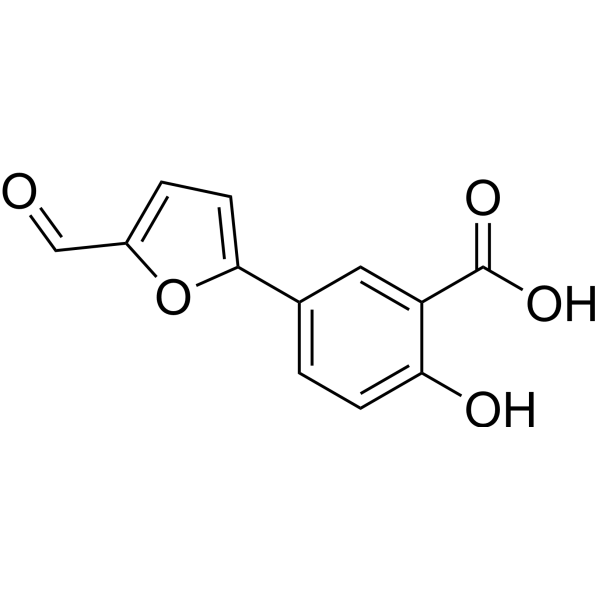
-
- HY-113013
-
|
β-Hydroxypyruvic acid; 3-Hydroxypyruvic acid
|
Endogenous Metabolite
|
Metabolic Disease
|
|
Hydroxypyruvic acid (β-Hydroxypyruvic acid) is an intermediate in the metabolism of glycine, serine and threonine. Hydroxypyruvic acid is a substrate for serine-pyruvate aminotransferase and glyoxylate reductase/hydroxypyruvate reductase. Hydroxypyruvic acid is involved in the metabolic disorder which is the dimethylglycine dehydrogenase deficiency pathway.
|
-
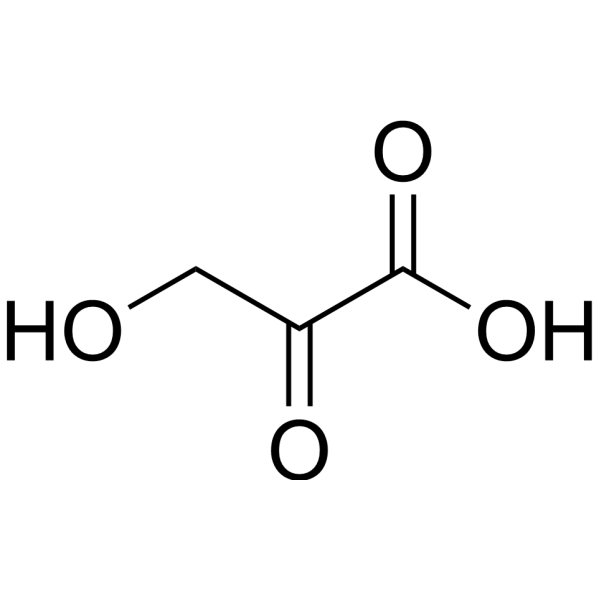
-
- HY-113013A
-
|
β-Hydroxypyruvic acid lithium hydrate; 3-Hydroxypyruvic acid lithium hydrate
|
Endogenous Metabolite
|
Metabolic Disease
|
|
Hydroxypyruvic acid lithium hydrate (β-Hydroxypyruvic acid lithium hydrate) is an intermediate in the metabolism of glycine, serine and threonine. Hydroxypyruvic acid lithium hydrate is a substrate for serine-pyruvate aminotransferase and glyoxylate reductase/hydroxypyruvate reductase. Hydroxypyruvic acid lithium hydrate is involved in the metabolic disorder which is the dimethylglycine dehydrogenase deficiency pathway.
|
-
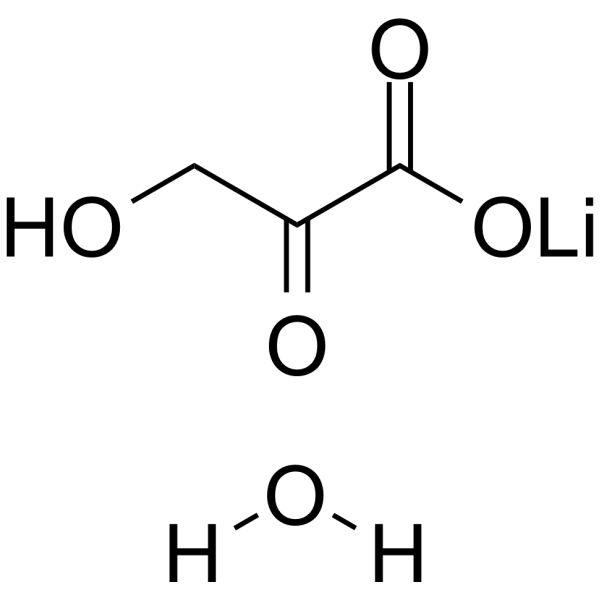
| Cat. No. |
Product Name |
Type |
-
- HY-W099490
-
|
|
Fluorescent Dyes/Probes
|
|
Bis[3,4,6-trichloro-2-(pentyloxycarbonyl)phenyl] oxalate is a fluorescent dye that can be used for generation of chemiluminescence .
|
| Cat. No. |
Product Name |
Type |
-
- HY-19695
-
|
L-p-Bromotetramisole oxalate; 6-Bromolevamisole oxalate
|
Biochemical Assay Reagents
|
|
(-)-p-Bromotetramisole Oxalate is a potent and non-specific alkaline phosphatase inhibitor.
|
-
- HY-W127854
-
|
|
Biochemical Assay Reagents
|
|
Bis(pentafluorophenyl) Oxalate is a biochemical reagent that can be used as a biological material or organic compound for life science related research.
|
-
- HY-W042438
-
|
|
Biochemical Assay Reagents
|
|
Bis(2,4,6-trichlorophenyl) oxalate is a biochemical reagent that can be used as a biological material or organic compound for life science related research.
|
| Cat. No. |
Product Name |
Target |
Research Area |
-
- HY-110366
-
|
SAX-187 oxalate
|
5-HT Receptor
|
Neurological Disease
|
|
WAY-181187 (SAX-187) oxalate is a potent and selective full 5-HT6 receptor agonist with a Ki of 2.2 nM and an EC50 of 6.6 nM. WAY-181187 oxalate mediates 5-HT6 receptor-dependent signal pathways, such as cAMP, Fyn and ERK1/2 kinase, as specific agonist .
|
| Cat. No. |
Product Name |
Category |
Target |
Chemical Structure |
| Cat. No. |
Product Name |
Chemical Structure |
-
- HY-14258AS
-
|
|
|
Escitalopram-d6 (oxalate) is the deuterium labeled Escitalopram oxalate. Escitalopram ((S)-Citalopram) oxalate, the S-enantiomer of racemic Citalopram, is a selective serotonin reuptake inhibitor (SSRI) with a Ki of 0.89 nM. Escitalopram oxalate has ∼30 fold higher binding affinity than its R(-)-enantiomer and shows selectivity over both dopamine transporter (DAT) and norepinephrine transporter (NET). Escitalopram oxalate is an antidepressant for the research of major depression[1][2].
|
-

-
- HY-A0118AS
-
|
|
|
Naloxegol-d5 (oxalate) is deuterium labeled Naloxegol (oxalate). Naloxegol oxalate (NKTR-118 oxalate; AZ-13337019 oxalate) is a μ-opioid-receptor antagonist. Naloxegol oxalate inhibits opioid binding in μ-opioid receptors in the gastrointestinal tract and effective for alleviating opioid-induced constipation[1][2].
|
-

-
- HY-14258AS1
-
|
|
|
Escitalopram-d4 (oxalate) is deuterium labeled Escitalopram (oxalate). Escitalopram ((S)-Citalopram) oxalate, the S-enantiomer of racemic Citalopram, is a selective serotonin reuptake inhibitor (SSRI) with a Ki of 0.89 nM. Escitalopram oxalate has ∼30 fold higher binding affinity than its R(-)-enantiomer and shows selectivity over both dopamine transporter (DAT) and norepinephrine transporter (NET). Escitalopram oxalate is an antidepressant for the research of major depression[1][2].
|
-

-
- HY-121203S1
-
|
|
|
Citalopram-d6 oxalate is the deuterium labeled Citalopram oxalate .
|
-

-
- HY-132373S
-
|
|
|
N-Hydroxy Mexiletine-d6 Oxalate is the deuterium labeled N-Hydroxy Mexiletine Oxalate[1].
|
-

-
- HY-143931S
-
|
|
|
N-Desmethyl citalopram-d4 (oxalate) is the deuterium labeled N-Desmethyl citalopram oxalate[1].
|
-

-
- HY-110289S1
-
|
|
|
(R)-Citalopram-d4 (oxalate) is deuterium labeled (R)-Citalopram Oxalate.
|
-

-
- HY-151910S1
-
|
|
|
(±)-Fluoxetine-dd5 Oxalate (phenyl-dd5) is the deuterium labeled (±)-Fluoxetine Oxalate[1].
|
-

-
- HY-151910S
-
|
|
|
(±)-Fluoxetine-d4 Oxalate (trifluoromethylphen-d4-oxy) is the deuterium labeled (±)-Fluoxetine Oxalate[1].
|
-

-
- HY-126568S1
-
|
|
|
Nafronyl-d4 (oxalate) is deuterium labeled Naftidrofuryl.
|
-

-
- HY-132475S
-
|
|
|
rac Duloxetine 3-Thiophene Isomer-d3 Oxalate is a stable isotope of Duloxetine.
|
-

Your information is safe with us. * Required Fields.
Inquiry Information
- Product Name:
- Cat. No.:
- Quantity:
- MCE Japan Authorized Agent:















































![Bis[3,4,6-trichloro-2-(pentyloxycarbonyl)phenyl] <em>oxalate</em>](http://file.medchemexpress.com/product_pic/hy-w099490.gif)










